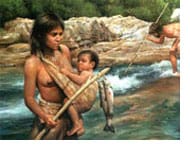
Understanding one’s ancient ancestry is rarely the primary reason for DNA testing. Most of us test our DNA with more immediate goals in mind. Like confirming a close relationship. Or extending a family tree.
Unless you have a very rare set of markers, your least specific test comparisons will probably reveal many matches. And these people can’t all be close relatives.
For example, on the first 12 markers of my Y-DNA test I match about one hundred men. In the HVR-1 region of my mtDNA test, I match more than 1,500 people.
While I must share a common ancestor with each of these genetic cousins, most of those common ancestors lived many hundreds or even thousands of years ago.
Geneticists and anthropologists use DNA markers to understand the origins of modern humans and trace their migrations. By determining our haplogroups though readily available home DNA tests, we can discover our personal ancient ancestry.
The mtDNA that we all inherit from our mothers is particularly useful for discovering our ancient ancestry. It lets scientists identify and trace separate genetic lines within human populations. Furthermore, the mutation rate acts as an evolutionary clock over these long time periods.
The Seven Daughters of Eve
The pioneer in this field of study was Bryan Sykes, a Professor of Human Genetics at Oxford University in England. He discovered that people tend to cluster into a relatively small number of groups, defined by the precise sequence of their mtDNA.
In Europe about 95% of the population falls into seven such groups, known as haplogroups, categorized by the letters U, X, H, V, T, K, and J.
That was the basis for Sykes’ book, The Seven Daughters of Eve. To emphasize that the first women in each haplogroup were real individuals, Sykes gave them all names, like Ursula, Xenia etc. Then, using archaeological and other evidence, he reconstructed fictional accounts of their lives.
A Global Concept
Obviously, these findings do not just apply to ancient ancestry in Europe. Among Native Americans there are four groups, among Japanese people there are nine, and so on. Sykes and others have defined about 40 of these clans worldwide.
Logically, each of these groups must trace back to just one woman, the common maternal ancestor of everyone in her group or clan. These women did not live in the same time and place. And there were other women around, of course.
Yet these clan mothers are the only ones whose maternal lineage survives unbroken right through to the present day. Since only women can pass on their DNA, all of the other lines terminated when a woman in that particular line did not have a daughter.
All of these major maternal lines go back further in time to “Mitochondrial Eve,” a woman who lived about 140,000 years ago in Africa. Like the other clan mothers, Eve was not alone. But the direct maternal lines of her contemporaries all terminated somewhere in human history.
Y-DNA Adam
Scientists are also studying DNA from the Y chromosome, which only passes from father to son. If you’re a man, your Y-DNA test results place you in one of about 20 main branches of the paternal tree.
To make things confusing, scientists also categorize these male haplogroups by letters of the alphabet. Naturally, there is some overlap between the letters of the Y-DNA (paternal line) and mtDNA (maternal line) haplogroups. So know which one you’re looking at.
Each of these major haplogroups, or clades, can have subgroups, or subclades. Following the same logic as the female line, we can all trace our paternal ancestry back to a single male (Y-DNA Adam) who lived around 60,000 to 90,000 years ago.
How to Discover Your Ancient Ancestry
The quickest and least expensive way to get an overview of your ancient ancestry is through the 23andMe test. This will estimate your maternal and paternal (for men only) haplogroups. It also provides an Ancestry Composition report that breaks your overall ancestry into European, African, Asian and other subgroups, including Native American.
For more options to examine your ancestry in depth I recommend Family Tree DNA. Their product offering includes several Y-DNA and mtDNA test options, including the only test available that checks 100% of your mitochondrial DNA.
Their Family Finder test includes a myOrigins report, formerly called Population Finder that checks your ancestry against more than 60 scientifically accepted population groups.
Their least expensive tests are adequate to determine your basic paternal and maternal haplogroups. But higher level tests are more likely to provide genealogists with useful matches to biological relatives. See my Family Trees section for more information on genetic genealogy.
Once you have a man’s Y-DNA test results, you can order a deep clade test to refine his haplogroup into a more specific subclade.
For example, my first Y-DNA test predicted my basic paternal haplogroup as R. This told me that my paternal ancestry was most likely from Western Europe. Later, a deep clade test refined that to R-L21. Now my probable origins are defined more precisely as England and Ireland.
Likewise, my first mtDNA test defined my maternal haplogroup as H, the most common mtDNA haplogroup in Europe. When I upgraded to the full sequence mtDNA test, my maternal haplogroup was refined to H5a7.
